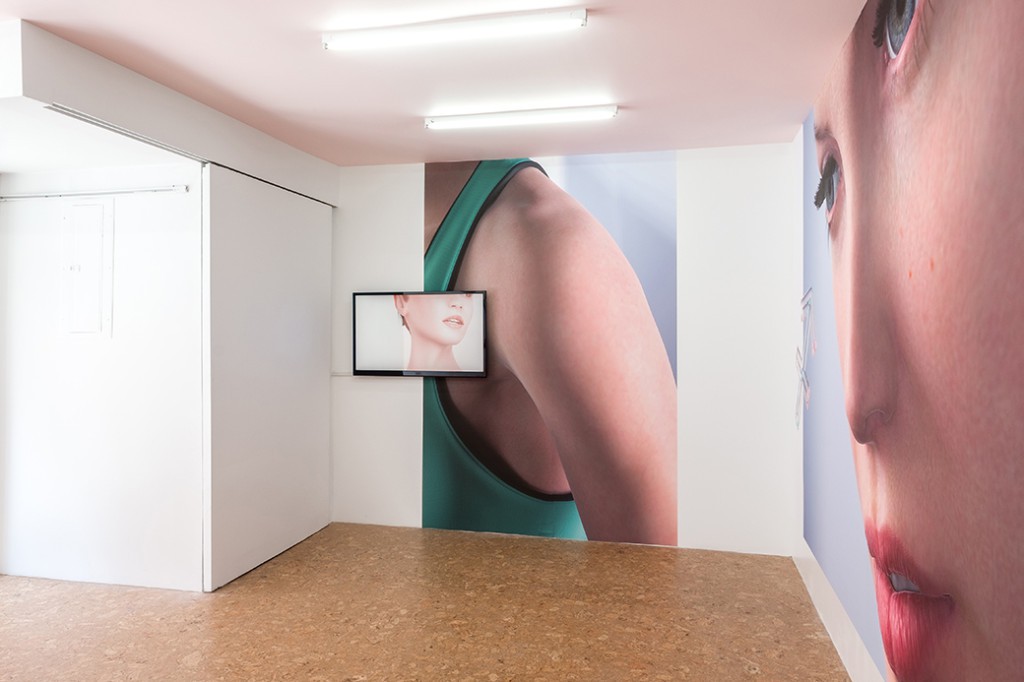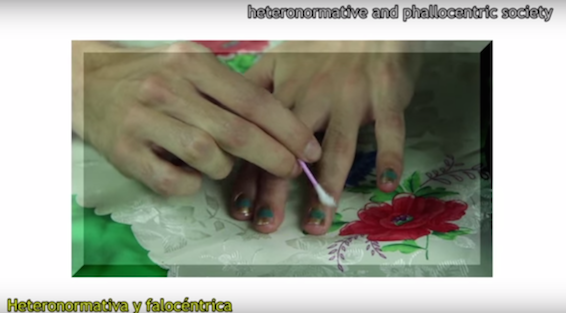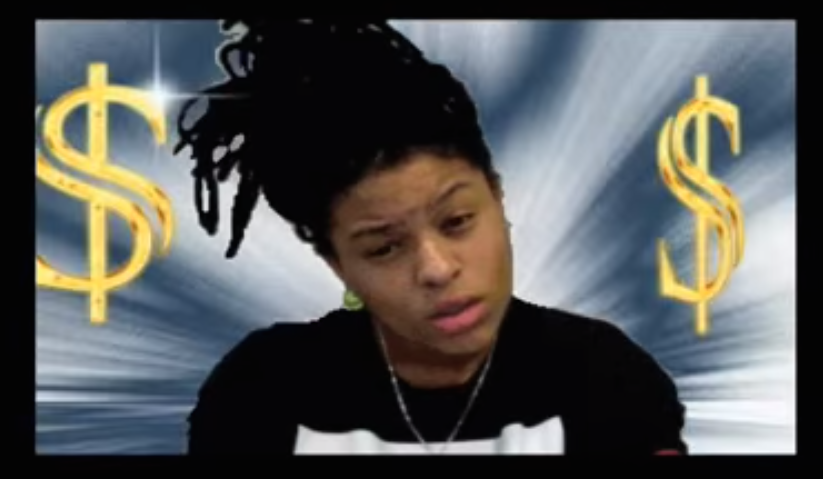
Kate Cooper, “Rigged” (2014/2015). Digital prints, looped HD video with sound, 6:22 min. Image via K-Period.
Guess who’s happy all the time? Not many artists. While on the happiness scale artists may rank somewhere between a dog without a bone and an emo kid’s Livejournal, don’t blame ’em for trying. Dotted throughout history, art has existed as a tool to produce happiness—see the diagram of the 1964 sculpture Happiness Machine by Adrian Guillery and Dick Hogle. Happiness does not exist on its own, like a natural element; it needs to be squeezed out with a tool, plan, or machine. Happiness cannot be permanent, just temporary.
The happiness machine in contemporary art is a digital one, with artists putting on the guises of online self-help gurus or playing around with referencing online tutorials. YouTube Self-Betterment is the game, and the aim is the creation of an entirely new self, if only for the length of time it takes a manicure to peel.
1) How to be happy: Quantify yourself.
For those who may be unfamiliar with the quantified-self (QS) movement, it aims at happiness through tracking one’s data. It’s a big deal for those involved in this This Lifestyle, which boasts conferences, podcasts, and blogs,. This is not for one with an analogue -mindset, however; The data-obsessed practice is based on home tech, through wearables like Fitbit, or financial apps like Mint. Such helpful devices, not only track your current life choices, but also make suggestions based on how they predict you will act in the future.
The prediction-based suggestions of QS don’t give you as much control, or pleasure, as QS devotees describe. Kate Cooper’s work Rigged presents digital prints and video of a computer-generated image of a young woman in fitness clothing. This CGI character is not flawless and has to work to be perfect, which is rare for tech videos. In the first shot, she wears a retainer-and-braces-like mouth contraption that seems painful. Working on controlling herself through data has not brought her happiness, and she has worked hard at perfecting her body—there is digital sweat—only to want to be rid of it. She wishes to “disappear completely” because she has become “a multiplicity of beings,” as she says in the video component of Rigged. She has worked to look healthy, to the point that her skin, she says, can be implanted on another self in the future. “Skin,” she says in the video, is “the only object l have left.” Her aim? To “disappear completely” because, through the many versions of selfhood she has become “a multiplicity of beings.”
2) How to be happy: Be real. If you can’t be real, just be real enough.
While high-tech options increasingly become the norm, there remains the refreshingly familiar simplicity of YouTube videos. In contrast to the QS movement, participating in the culture of YouTube tutorials is more economically egalitarian. Making a YouTube video tutorial is fairly easy to learn, without requiring much patience or technical know-how. YouTube advertises that three hundred hours of video are uploaded every minute, and teenagers find YouTube celebrities more influential than traditional TV and film stars, for their likeability and seeming authenticity, according to a Variety survey. And it’s no wonder; it seems anyone can become famous on YouTube for doing something fairly simple, like painting one’s nails.

Emilio Bianchic, “EASY SIMPLE NAIL ART TUTORIAL FREE FEMINIST FIFA LANA DEL REY ROAR” nail tutorial (2014)
The artist Emilio Bianchic has perfected the nail-tutorial video, on YouTube and in the art gallery. In EASY SIMPLE NAIL ART TUTORIAL FREE FEMINIST FIFA LANA DEL REY ROAR, a bilingual instructional video (featured in a solo show at Postmasters, curated by Kerry Doran), Bianchic gives simple tips with a retro MIDI flair that’s unmistakably artful. “Everyone got nails and everyone could be an artist…Follow me”; some of the tips are political: “Painting your nails is for everyone, every gender and sexual orientation.”[1] Toward the end of the video, Bianchic shows the simple, democratic stylings of nail art: you can paint whatever you want on your nails, from a replica of the Berlin Wall to a fried egg.
In works by video artists who emerged several years ago, happiness could be found through an avatar (as in videos by Ryan Trecartin) or transcendence through New Age spirituality (see works by Shana Moulton). Unlike these earlier models, today’s self-betterment exists on a real level, and even painting one’s nails can send them to a new plane. For instance, in the trailer to Wildlife, Bianchic is transported to a rave of nail-painting, in contrast to the character Cynthia in Moulton’s eighth episode of Whispering Pines, who finds herself in an Enya-themed rave only after performing rituals and drinking large amounts of Crystal Light. Even the artist Casey Jane Ellison, the self-proclaimed “inventor of the comedian avatar,” looks like a twin of her digital avatar, unlike Ryan Trecartin’s fast-talking, face-painted, costumed “avvys.”
3) How to be happy: FITYMI.
FITYMI, or “fake it ’til you make it,” is kind of a last resort but a popular way to find Internet happiness. Many an Internet star has shot to fame and acceptance by branding him, her- or their- gender-non-specific self as a perfect ten. Lil B, the Based God, is the go-to example for how to make a name for yourself by acting like you’re already on top.
The artist Nandi Loaf’s YouTube Nonchalant Freestyle // artist statement video shares the charisma of the Based God. Texts appear below a still image of the artist: “Hi, I am Nandi Loaf & you guys suck. <3.” She then reads off a laundry list of artists she hates: “Fuck Basquiat. Fuck Cindy Sherman. Fuck Picasso.”[2]
In the digital age, anxiety about one’s elders is too much of a burden on happiness. Given the speed at which fads come and go in social media, even Trecartin may seem dated. So if one want to be an artist, it may do to call out one’s predecessors, as Loaf does, in order to make a digital room of one’s own. Loaf’s YouTube bio states, “Nandi Loaf is the most influential artist of the 21st century.” If Lil B can be the Based God, then Nandi Loaf can be whatever she wants to be. And isn’t being what one wants to be—even temporarily—enough to make one happy?
—
[1] Emilio Bianchic, EASY SIMPLE NAIL ART TUTORIAL FREE FEMINIST FIFA LANA DEL REY ROAR, YouTube, September 21, 2014, https://www.youtube.com/watch?v=5gqM6PMSFcE&feature=youtu.be and https://rhizome.org/editorial/2014/oct/8/lipstick-traces-digital-polish/?ref=carousel_p3
[2] Nandi Loaf, Nonchalant Freestyle // artist’s statement @Nandi_Loaf, YouTube, February 7, 2014, https://www.youtube.com/watch?v=esAxruL03qw&feature=youtu.be.




